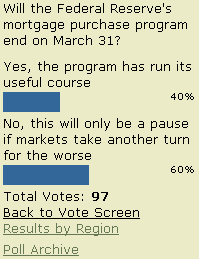- The Wall Street Journal – Investors Look for Clues in Fed Orations
This year may turn out to be one with a whole lot of talk and a lot less action from the Federal Reserve. Fed officials have been an unusually vocal bunch lately, and that is set to continue this week. On Tuesday alone, regional Fed presidents Dennis Lockhart, Charles Plosser and Narayana Kocherlakota will be giving public speeches. Also on Tuesday, the Fed will release the minutes from its last policy meeting, offering further detail on how officials think the inflation and growth outlook is evolving. The question investors are puzzling over is what signal, if any, to glean from all the noise, especially recent remarks from Messrs. Kocherlakota and Plosser suggesting the fed-funds lending rate could hit 1% by year end and 2.5% by the middle of next year. It is near zero today. Such talk is often the first way the Fed communicates with markets that a change is coming. - The Wall Street Journal – Bernanke Plays Down Threats of Inflation
Federal Reserve Chairman Ben Bernanke Monday downplayed inflation threats to the U.S. economy, despite recent warnings from some of his central bank colleagues that their easy money policies may need to be tightened this year to keep prices in check…Mr. Bernanke’s remarks, which came in response to audience questions at a conference held by the Federal Reserve Bank of Atlanta, indicated he doesn’t share inflation concerns aired recently by a vocal minority of central bank officials. Other Fed officials’ recent comments have left markets somewhat uncertain about the Fed’s policy direction. The loudest voices in recent weeks have come from the Fed’s hawkish wing, those policymakers who tend to worry more than others about inflation. Officials like Philadelphia Fed President Charles Plosser and Dallas Fed President Richard Fisher have led many market participants to believe the central bank is moving closer to tighten monetary policy to keep a lid on prices.
Comment
If this story sounds familiar, it should. A similar divide between economists and traders existed at the end of the Federal Reserve’s mortgage purchase program on March 31, 2010. Shown below, 60% of our customers correctly believed that March 31 would only prove to be a pause in quantitative easing rather than its official end. As we said in March 12, 2010 and again echoed on CNBC on March 17, 2010:
Our anecdotal and completely unscientific discussion with mortgage traders shows that a fair number believe April 1st [2010] will only prove to be a pause in the purchase program and not the end. When things again get wobbly, they expect the Federal Reserve to re-enter with a new mortgage purchase program. If a lot of people in this market are banking on the Federal Reserve’s continued subsidy, then April 1 [2010] could see some volatility and materially wider spreads in mortgages if this does not come to fruition. If Wall Street’s consensus is that the Federal Reserve is leaving for good on March 31 [2010], then this could already be priced in and April 1 [2010] could be a non-event.
March 2010 Poll

Now that the market again appears to be divided on this issue, will history repeat itself and prove traders to be more attuned to the prospects for further quantitative easing? The hawks at the Federal Reserve are becoming more vocal, but our quick survey of clients shows a slight majority of traders actually believe some form of further quantitative easing should not be ruled out.
